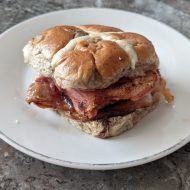In recognition of international talk like a pirate day I shall be wandering up and down the Mile End Road with a plastic carrier bag, accosting all and sundry saying only “DVDs?”
Apple batteries and Virgin Atlantic
I see from Slashdot reports that Virgin Atlantic are banning all Apple and Dell batteries due to potential fire hazards. The fact it is the Sony made batteries that exhibit this fault, and are found in many other laptops besides those made by Apple and Dell seems to have been ignored.
At the second security checkpoint, just before boarding the plane at Heathrow, I was asked to remove the battery from my Powerbook. The Powerbook was in sleep mode at the time, so I had to stand to one side, start up and then shut down the machine to safely remove the battery. Once done I presented the Powerbook and battery to a second guard who asked why I had done this and professed to know nothing about such a ban. On the return trip, no one said anything about the battery.
This seems more like an effort to be seen to be doing something on the part of Virgin Atlantic rather than any real attempt to prevent a potential problem. I’ll not argue that Li batteries are harmless, indeed I read recently in a us.mil report that modern fully charged Li-Polymer batteries are approaching 1/3 the energy density of TNT. The report illustrated this with dramatic photographs of the results of batteries malfunctioning in active service.
I wonder just how many other Li batteries were on that Heathrow-Dulles flight that were not on the banned list. I know I was carrying another four in my hand luggage; PSP, camera & spare and mobile ‘phone.
That was the week that was
Well, I survived the flights with minimal sedation. I’ve no idea just what is in the wine they serve in battery-hen class on Virgin Atlantic, but it isn’t alcohol. Or rather, it has none of the time-warping effects of alcohol.
I actually got back last Monday, I’ve just been otherwise occupied and unable to update here. In addition to the 3000ish miles I few back home Sunday night / Monday morning; I’ve added another 500 or so travelling around South England and South Wales for reasons both personal and pleasurable.
Back to work in earnest next week. Only two more weeks of that and I’m jobless. Bum. Back to temping for a couple of months I think while I find something fun to do again.
An American adventure
I’m off to the US for a week. Sunny Virginia via gun ridden Washington DC for a laser conference.
Seven hours spent blasting though the skies at a few hundred MPH several miles above the ground ‘fun’. I hate flying. Taking off and landing is no problem, but the sheer mindnumbing tedium of of the actual flying part gets to me. I do wish sedation were an option on long flights. Yes, I consider seven hours a long flight, anything more than 2 hours taxes my patience.
Note to self: Invent teleportation when you get back to the lab.
Apple battery recall
I’ve switched off my G4 Powerbook for the first time in about 6 months to pull the battery and see if I’m eligible for a new one under the Apple battery recall program. I was rather hoping I was, because battery life on the laptop is now down to about 45 min. A shiny new battery would be very welcome.
Alas it is not to be, I have one of the nonexplodey battery types. Having just seen the price of a replacement battery for this machine I fear I shall be living with an ageing battery for quite a long while to come.
